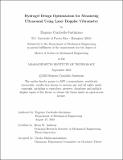Hydrogel Design Optimization for Measuring Ultrasound Using Laser Doppler Vibrometry
Author(s)
Caraballo-Justiniano, Eugenio
DownloadThesis PDF (23.20Mb)
Advisor
Anthony, Brian W.
Terms of use
Metadata
Show full item recordAbstract
Over the past decade, work in the medical field has been geared towards the development
of ultrasonic systems for medical diagnostic imaging applications. Compared to
other imaging modalities, patient contact is a significant source of variability unique
to ultrasound. Contact sensitive applications such as remote patient/neonatal monitoring,
tracking wound healing, and imaging of sensitive skin areas can significantly
benefit from a non-contact ultrasound system. Laser ultrasound (LUS) imaging offers
potential advancements over conventional ultrasound, especially in achieving highresolution
imaging of tissue structures and the elimination of liquid coupling mediums
and probe-to-body contact. The thesis presents an innovative approach to enhance
the performance of LUS signals in human tissue by utilizing hydrogels, hydrophilic
polymeric materials known for high-water content and biocompatibility, as a surface
treatment layer for ultrasound detection and generation. The system integrates
and synchronizes linear stage automation, transducer acoustic wave generation, laser
doppler vibrometry (LDV), and LabView integration. High speed data acquisition
(DAQ) through a dedicated Pico Technology setup streams digitized data directly to
the host PC. LDV measurements highlighted the crucial role of bead concentration
within hydrogels. Velocity amplitude measurements reflected an inverse relationship
with increasing bead concentrations, peaking at approximately 700 mm/s. However,
higher bead concentrations yielded better data accuracy and reduced noise, suggesting
an optimal range for bead concentration.A comparison of noise ranges across different
hydrogel bead concentrations highlighted improved data quality and precision for
concentrations exceeding 0.015 g/mL. Furthermore, laser-based measurements indicated
that hydrogel with a bead concentration of 0.02 g/mL provided consistent and
enhanced signal amplitude. The findings present a pivotal step towards optimizing
LUS for clinical applications, opening new doors in medical imaging and diagnostics.
Date issued
2023-09Department
Massachusetts Institute of Technology. Department of Mechanical EngineeringPublisher
Massachusetts Institute of Technology